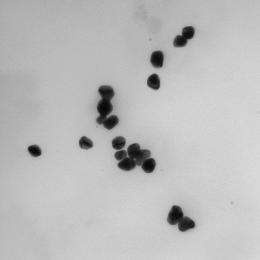High-tech tactic may expose stealthy salmonella

Even the smallest quantity of Salmonella may, in the future, be easily detected with a technology known as SERS, short for "surface-enhanced Raman scattering." U.S. Department of Agriculture (USDA) scientist Bosoon Park at Athens, Ga., is leading exploratory studies of this analytical technique's potential for quick, easy and reliable detection of Salmonella and other foodborne pathogens.
According to the U.S. Centers for Disease Control and Prevention, Salmonella causes more than one million cases of illness in the United States every year.
If SERS proves successful for cornering Salmonella, the technique might be used at public health laboratories around the nation to rapidly identify this or other pathogens responsible for outbreaks of foodborne illness, according to Park, an agricultural engineer with USDA's Agricultural Research Service (ARS). What's more, tomorrow's foodmakers might use SERS at their in-house quality control labs.
ARS is USDA's chief intramural scientific research agency. Park's research supports the USDA priority of enhancing food safety.
In a SERS analysis, a specimen is placed on a surface, such as a stainless steel plate, that has been "enhanced" or changed from smooth to rough. For some of their research, Park's team enhanced the surface of stainless steel plates by coating them with tiny spheres, made up of a biopolymer encapsulated with nanoparticles of silver.
Rough surfaces, and colloidal metals such as silver, can enhance the scattering of light that occurs when a specimen, placed on this "nanosubstrate," is scanned with the Raman spectrometer's laser beam.
The scattered light that comes back to the spectroscope forms a distinct spectral pattern known as a Raman spectral signature, or Raman scattered signal. Researchers expect to prove the concept that all molecules, such as those that make up Salmonella, have their own unique Raman spectral signature.
The idea of using a substrate of silver nanoparticles for Raman spectroscopy is not new. But in SERS studies to detect foodborne pathogens, the use of a surfac—enhanced with biopolymers coated with silver nanoparticles—is apparently novel.
In work with comparatively large concentrations of two different kinds, or serotypes, of Salmonella enterica—Enteritidis and Typhimurium—Park's tests showed, apparently for the first time, that SERS can differentiate these two serotypes. With further research, SERS may prove superior for finding very small quantities of bacteria in a complex, real-world background, such as a food or beverage sample, Park notes.
He collaborated in the research with Arthur Hinton, Jr., Kurt C. Lawrence, Jaya Sundaram, William R. Windham, and Seung Chul Yoon, all with ARS at the agency's Richard B. Russell Research Center in Athens; Yao-Wen Huang and Yiping Zhao of the University of Georgia-Athens; Yongkuk Kwon of South Korea's Animal, Plant, and Fisheries Quarantine and Inspection Agency; and others.
More information: Read more about the research in the April 2012 issue of Agricultural Research magazine.
Provided by USDA Agricultural Research Service



















